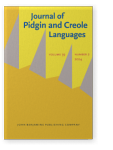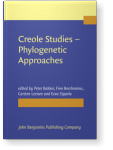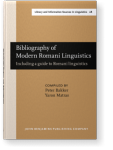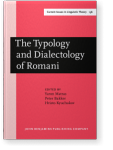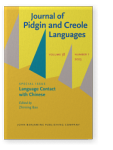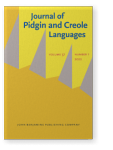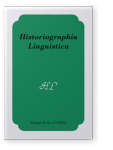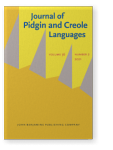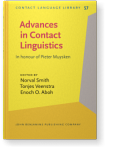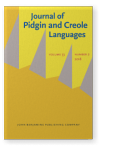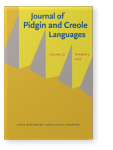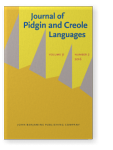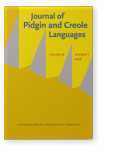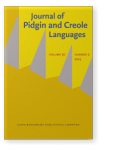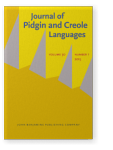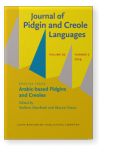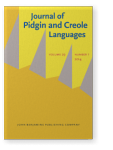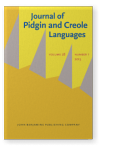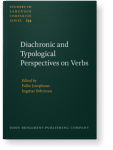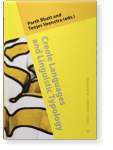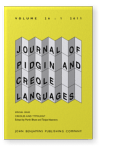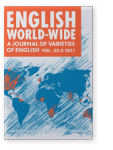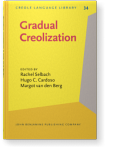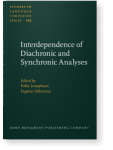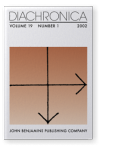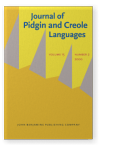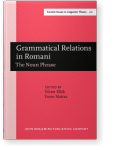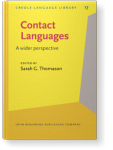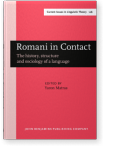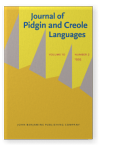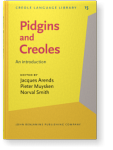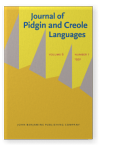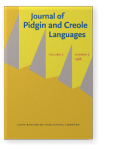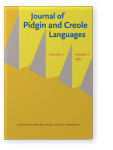Peter Bakker
List of John Benjamins publications for which Peter Bakker plays a role.
Book series
Journal
ISSN 0920-9034 | E-ISSN 1569-9870
Titles
Creole Studies – Phylogenetic Approaches
Edited by Peter Bakker, Finn Borchsenius, Carsten Levisen and Eeva M. Sippola
[Not in series, 211] 2017. x, 414 pp.
Subjects Contact Linguistics | Creole studies | Historical linguistics | Theoretical linguistics
Bibliography of Modern Romani Linguistics: Including a guide to Romani linguistics
Compiled by Peter Bakker and Yaron Matras
[Library and Information Sources in Linguistics, 28] 2003. xxviii, 366 pp.
Subjects Bibliographies in linguistics | Theoretical linguistics
The Typology and Dialectology of Romani
Edited by Yaron Matras, Peter Bakker and Hristo Kyuchukov
[Current Issues in Linguistic Theory, 156] 1997. xxxii, 223 pp.
Subjects Historical linguistics | Other Indo-European languages | Typology
2023 Empiricism against imperialism: Science, dogma and the neocolonial heritage of creole studies. Reflections on Meakins (2022) Journal of Pidgin and Creole Languages: Online-First Articles | Article
Large scale typological studies have been criticized for being unscientific, biased, methodologically unsound and as perpetrating neocolonial attitudes. Meakins (2022) echoes these views in her first JPCL column. The conclusions of all studies using large typological datasets, however, point in… read more
2023 Review of Operstein (2021): The Lingua Franca: Contact-Induced Language Change in the Mediterranean Language Contact with Chinese, Bao, Zhiming (ed.), pp. 202–206 | Review
2022 Pieter Cornelis Muysken (1950–2021) Journal of Pidgin and Creole Languages 37:1, pp. 1–9 | Obituary
2022 The Beginning of Quantitative Sociolinguistics in the Nineteenth Century: The Dane Anker Jensen (1878–1937) and his pioneering study “The Linguistic Situation in the Parish of Aaby, Aarhus County” (1898) Historiographia Linguistica 49:2/3, pp. 336–354 | Article
In 1898, a young Dane, Anker Jensen (1878–1937), published a pioneering study in which he investigated the linguistic situation in Aaby, then a village and parish located just west of Aarhus (the second-largest city of Denmark, in Jutland), and today an integrated part of the city. Anker… read more
2022 The Linguistic Situation in the Parish of Aaby, Aarhus County Historiographia Linguistica 49:2/3, pp. 355–371 | Translation
2020 The quest for non-European creoles: Is Kukama (Brazil, Peru) a creole language? Advances in Contact Linguistics: In honour of Pieter Muysken, Smith, Norval, Tonjes Veenstra and Enoch O. Aboh (eds.), pp. 85–106 | Chapter
Kukama has been classified firstly, as a Tupi-Guarani language, secondly, as a language that has undergone massive contact-induced change, and thirdly, as a creole. These different positions are surveyed against definitions of mixed languages and creoles, and properties of Tupi-Guarani languages. read more
2019 Kreolisch und Französisch . By Peter Stein Journal of Pidgin and Creole Languages 34:2, pp. 391–394 | Review
2018 Philip Baker (1940–2017) Journal of Pidgin and Creole Languages 33:2, pp. 231–239 | Obituary
2017 Chapter 16. Feature pools show that creoles are distinct languages due to their special origin Creole Studies – Phylogenetic Approaches, Bakker, Peter, Finn Borchsenius, Carsten Levisen and Eeva M. Sippola (eds.), pp. 369–373 | Chapter
2017 Chapter 10. Dutch creoles compared with their lexifier Creole Studies – Phylogenetic Approaches, Bakker, Peter, Finn Borchsenius, Carsten Levisen and Eeva M. Sippola (eds.), pp. 219–240 | Chapter
In this chapter, we compare lexical and grammatical data from three Dutch-based creoles: Virgin Islands Creole Dutch, Berbice Creole and Skepi Dutch of Guyana. We consider the lexicons, as well as phonological and typological patterns, and both synchronic and diachronic comparisons are made.… read more
2017 Chapter 2. Key concepts in the history of creole studies Creole Studies – Phylogenetic Approaches, Bakker, Peter, Finn Borchsenius, Carsten Levisen and Eeva M. Sippola (eds.), pp. 5–33 | Chapter
This chapter serves as a brief introduction to creole studies. It mostly deals with issues that are discussed in the book, but not exclusively. It starts with an introduction of terminology, and key terms are printed in CAPITALS. The second part presents a number of observations and claims that… read more
2017 Chapter 5. Creole typology I: Comparative overview of creole languages Creole Studies – Phylogenetic Approaches, Bakker, Peter, Finn Borchsenius, Carsten Levisen and Eeva M. Sippola (eds.), pp. 79–101 | Chapter
This chapter provides an overview of structural properties of creole languages based on widely different languages and spoken in a broad geographic range. We discuss phonology, morphology, syntax and lexicon. Phonologically, creoles tend to have average properties. Creoles are generally not… read more
2017 Chapter 4. Methods: On the use of networks in the study of language contact Creole Studies – Phylogenetic Approaches, Bakker, Peter, Finn Borchsenius, Carsten Levisen and Eeva M. Sippola (eds.), pp. 59–78 | Chapter
This chapter provides an overview of the phylogenetic models used in this book. In the introduction, we present the aims and limitations of the chapter and clarify some basic concepts. After presenting the steps of linguistic phylogenetic analyses, we proceed to explain the different data types… read more
2017 Chapter 3. Phylogenetics in biology and linguistics Creole Studies – Phylogenetic Approaches, Bakker, Peter, Finn Borchsenius, Carsten Levisen and Eeva M. Sippola (eds.), pp. 35–58 | Chapter
The main goal of this chapter is to introduce the reader to the parallels and commonalities that exist between the fields of biology and linguistics. Researchers from both fields faced similar problems when seeking to account for the descent and diversification of related entities (species,… read more
2017 Chapter 6. Creole typology II: Typological features of creoles: from early proposals to phylogenetic approaches and comparisons with non-creoles Creole Studies – Phylogenetic Approaches, Bakker, Peter, Finn Borchsenius, Carsten Levisen and Eeva M. Sippola (eds.), pp. 103–140 | Chapter
In the late 1950s, creolists started drawing lists of shared lexical and grammatical properties of creole languages. In this chapter, a number of proposals and features are presented. We show that few of the proposed common properties are in fact shared by all creoles. We also discuss… read more
2017 Chapter 7. West African languages and creoles worldwide Creole Studies – Phylogenetic Approaches, Bakker, Peter, Finn Borchsenius, Carsten Levisen and Eeva M. Sippola (eds.), pp. 141–174 | Chapter
In creole studies, there has been a long tradition of discussing the respective contributions of African languages in the genesis of creoles spoken primarily in the Atlantic and the Indian Oceans. Creolists have often assumed that the African languages that contributed to the creation of creoles… read more
2017 Chapter 1. Introduction Creole Studies – Phylogenetic Approaches, Bakker, Peter, Finn Borchsenius, Carsten Levisen and Eeva M. Sippola (eds.), pp. 1–4 | Chapter
2015 Creoles, creole studies and sign languages Journal of Pidgin and Creole Languages 30:2, pp. 357–369 | Article
2015 Creole languages have no… — but they do have… Journal of Pidgin and Creole Languages 30:1, pp. 167–176 | Article
2014 Creoles and typology: Problems of sampling and definition Arabic-based Pidgins and Creoles, Manfredi, Stefano and Mauro Tosco (eds.), pp. 437–455 | Article
2014 Creolistics: Back to square one? Journal of Pidgin and Creole Languages 29:1, pp. 177–194 | Article
2013 Diachrony and typology in the history of Cree (Algonquian, Algic) Diachronic and Typological Perspectives on Verbs, Josephson, Folke and Ingmar Söhrman (eds.), pp. 223–260 | Article
Cree and most of the other Algonquian languages show a number of typological unusual and inconsistent features. In this paper it is attempted to make sense of those, by applying internal reconstruction. The features discussed include the structural parallels between NP structure and VP structure,… read more
2013 Creoles are typologically distinct from non-creoles Creole Languages and Linguistic Typology, Bhatt, Parth and Tonjes Veenstra (eds.), pp. 9–45 | Article
In creolist circles, there has been a long-standing debate whether creoles differ structurally from non-creole languages and thus would form a special class of languages with specific typological properties. This debate about the typological status of creole languages has severely suffered from a… read more
2011 Creoles are typologically distinct from non-creoles Creoles and Typology, Bhatt, Parth and Tonjes Veenstra (eds.), pp. 5–42 | Article
In creolist circles, there has been a a long-standing debate whether creoles differ structurally from non-creole languages and thus would form a special class of languages with specific typological properties. This debate about the typological status of creole languages has severely suffered from… read more
2011 A phylogenetic networks approach to the classification of English-based Atlantic creoles English World-Wide 32:2, pp. 115–146 | Article
This paper deals with the issue of genetic relationships between English-based Atlantic creoles. A method borrowed from biology will be applied to a set of lexical and structural features found in the sample presented in Hancock (1987) in order to assess the degrees of affinity between these… read more
2009 The Saramaccan lexicon: Verbs Gradual Creolization: Studies celebrating Jacques Arends, Selbach, Rachel, Hugo C. Cardoso and Margot van den Berg (eds.), pp. 155–172 | Article
In this paper the inventory of verbs of Saramaccan Creole is investigated. Saramaccan is a lexically mixed creole, with mostly English and Portuguese lexicon. Even though it has been shown earlier that the Portuguese elements were superimposed on a preexisting English frame (Smith 1987), more verbs… read more
2008 The development of tense, mood, and aspect in the creole languages, and the typology of affix order Interdependence of Diachronic and Synchronic Analyses, Josephson, Folke and Ingmar Söhrman (eds.), pp. 43–59 | Article
Creole languages display systems of marking tense, mood and aspect (TAM) that are rather different from what is commonly found in non-creoles, but at the same time highly similar across creoles. In this chapter I will show some of these similarities and differences, and try to explain them with… read more
2000 External possession in Romani Grammatical Relations in Romani: The Noun Phrase, Elšík, Viktor and Yaron Matras (eds.), pp. 151–186 | Article
1997 Athematic morphology in Romani: The borrowing of a borrowing pattern The Typology and Dialectology of Romani, Matras, Yaron, Peter Bakker and Hristo Kyuchukov (eds.), pp. 1–22 | Article
1997 Michif: A mixed Language Based on Cree and French Contact Languages: A wider perspective, Thomason, Sarah G. (ed.), pp. 295–363 | Article
1997 Introduction The Typology and Dialectology of Romani, Matras, Yaron, Peter Bakker and Hristo Kyuchukov (eds.), pp. vii–xxx | Miscellaneous
1995 NOtes on the genesis of Caló and other Iberian Para-Romani varieties Romani in Contact: The history, structure and sociology of a language, Matras, Yaron (ed.), pp. 125–150 | Article
1994 3. Pidgins Pidgins and Creoles: An introduction, Arends, Jacques, Pieter Muysken and Norval Smith (eds.), pp. 25–39 | Chapter
1994 4. Mixed languages and language intertwining Pidgins and Creoles: An introduction, Arends, Jacques, Pieter Muysken and Norval Smith (eds.), pp. 41–52 | Chapter
1994 20. TMA particules and auxiliaries Pidgins and Creoles: An introduction, Arends, Jacques, Pieter Muysken and Norval Smith (eds.), pp. 247–258 | Chapter
1994 14. Saramaccan Pidgins and Creoles: An introduction, Arends, Jacques, Pieter Muysken and Norval Smith (eds.), pp. 165–178 | Chapter
1989 A French-Icelandic Nautical Pidgin Journal of Pidgin and Creole Languages 4:1, pp. 129–132 | Short note
1987 A Basque Nautical Pidgin: A Missing Link in the History of FU Journal of Pidgin and Creole Languages 2:1, pp. 1–30 | Article
The paper deals with a Basque Nautical Pidgin from which a number of sentences have been preserved in a seventeenth century Basque-Icelandic word list. These sentences are interesting for several reasons. First, Basque may throw an interesting light on the pidginization process because it is not an… read more
“Mij dodte, mij loppe, in mijn lande”: Extending the horizon on documented contact language use in the Virgin Islands with a quote in incipient Dutch Creole from 1681 Journal of Pidgin and Creole Languages: Online-First Articles | Article
A 1681 letter written by Jørgen Iversen (1638–1682), the first governor of Danish St. Thomas, unearthed from the Danish National Archives, contains a quote in incipient Virgin Islands Dutch Creole (VIDC). The quote, Mij dodte, mij loppe, in mijn lande, lit. ‘I die/dead, I go, in my country’… read more

